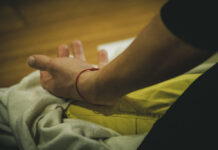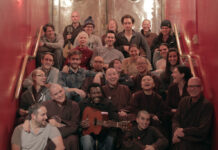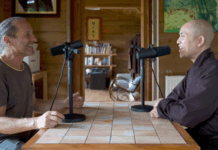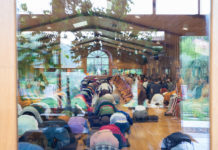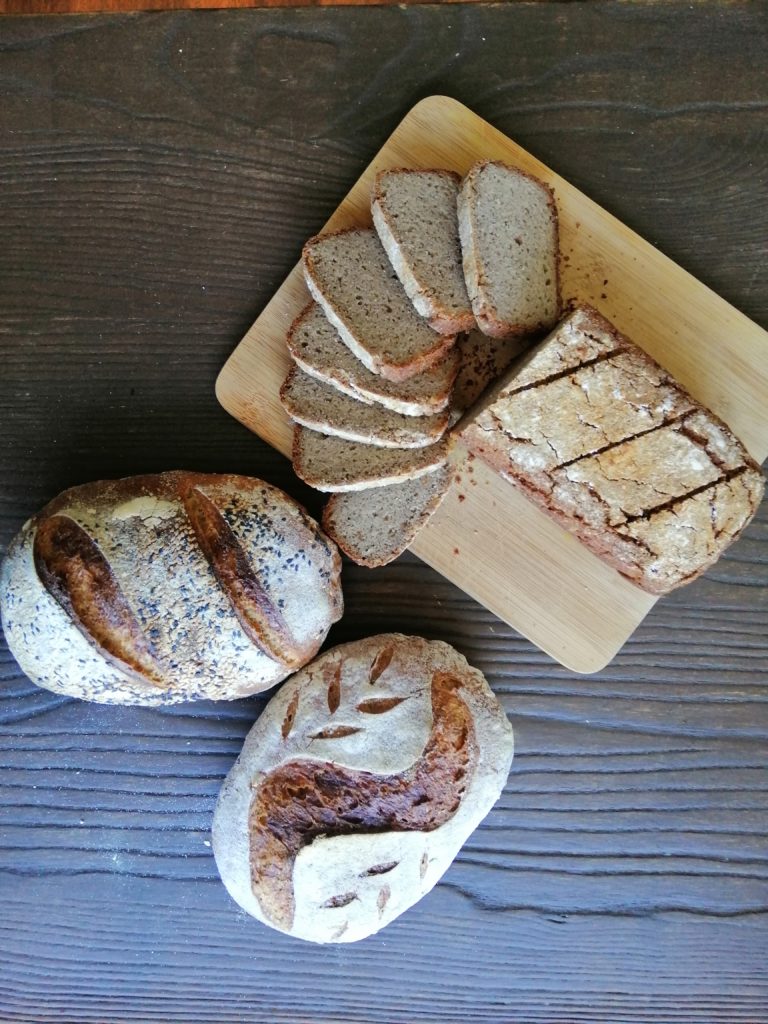
I suppose it is not too wild to assume that this strange time of pandemic has helped some of us uncover some interesting things about ourselves. Alongside with a lot of mud revealing itself, we might also see many lotuses blossoming and glistening under the bright light of awareness. Many lotuses have revealed itself for me in the form of making sourdough bread at home to overcome the muddy moments of boredom and agitation. Thay once said that if you look deeply you can see the Dharma everywhere. It is amazing how much teaching I can see in the three Jewels of flour, water and salt.
The reality is that a beautiful sourdough loaf always starts like a saggy mess when all the conditions first come together in their most raw form. In some cases, it can be a bit dry and flaky. In other cases, it is sticky and lumpy. But the one thing all doughs have in common at this stage is their lack of structure and disharmony in consistency. Some people may want to work on this mess straight away and get it together. But a true baker knows the “autolyse” process would be the wisest thing to do. Autolysing simply means to let the dough sit for an extended period of time after mixing, without any kneading. During autolysis the flour absorbs the water and becomes fully hydrated. This activates enzymes in the flour that stimulate the proteins to start developing the gluten network. It is much like the practice of sitting with whatever is arising in the moment in order to be fully aware of its true nature, allowing wisdom on how to be with it to arise naturally. Some suggest to let the autolyse process last for up to four hours in order to let the dough gain full elasticity. How long can we allow ourselves to sit with our mud?
Can we recognize that the
softening of our heart is the
sign of the strengthening
of our mind?
Then comes a series of stretches and folds to really bring the magic of fermentation to the dough. This is when the dough begins its journey of transformation into a whole new world of strength, resilience and flavor. Many things can coexist, but rushing does not seem to go together well with sourdough bread making. After some stretching and folding, it is essential to let our dough relax to incorporate the structure into its new shape before the whole process repeats all over again. After some resting time, the dough will be much smoother and softer yet stronger at the same time. Do you find yourself needing some healing time after a storm passes through? Our teacher Thay constantly reminds us to make sure that the cultivation of joy and happiness happens simultaneously with the transformation of pain and suffering so as to not overwhelm us. Those who have been on the path of transforming suffering can surely agree that it is a never-ending journey. Many professional bakers would suggest multiple “stretch and fold” sessions with plenty of resting time in between. How many times are you willing to let yourself be stretched and folded, to face your challenges with fearlessness and vulnerability? Can we recognize that the softening of our heart is the sign of the strengthening of our mind?
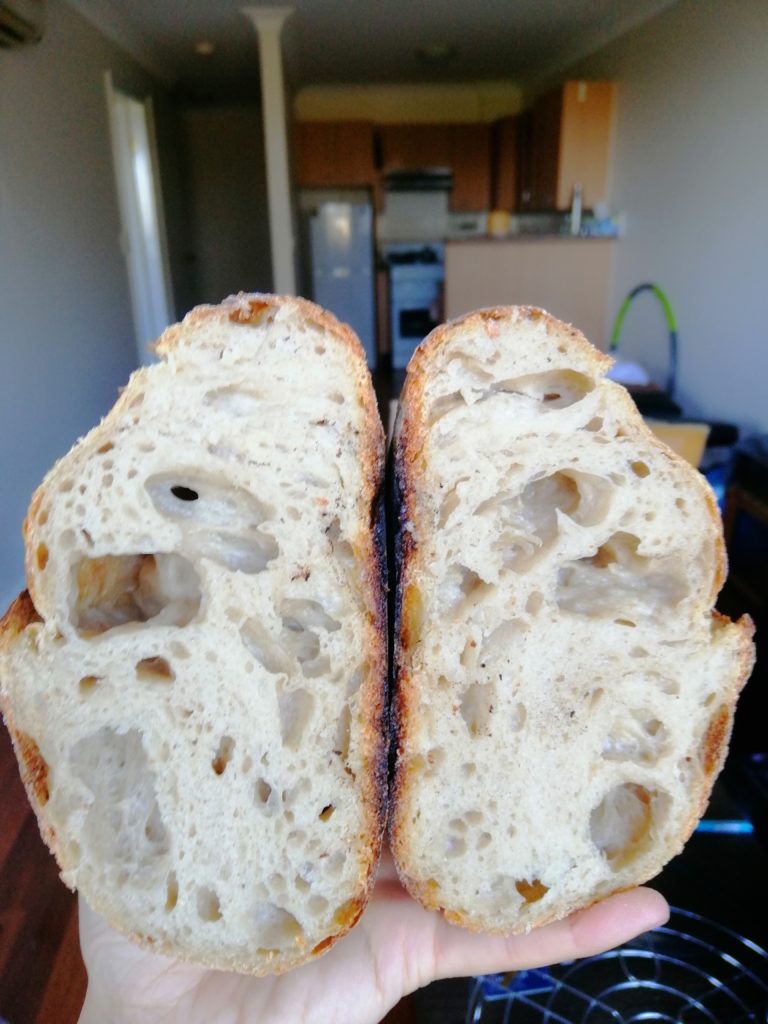
It is time to finally shape our dough. Would you like it to be a batard, miche or boule? I guess it is not all that important, it’s just forms and signs. It all depends on the size and shape of the equipment we have to use around us. What good comes from trying to shape a long bread to fit into an oval oven? It likely results in creating strain and resentment. Sometimes we must overlook the outer form and appreciate all the goodness that has been there all along. Whatever way we choose to be, let us be with integrity and gentleness at the same time. It is crucial to handle our dough with constant mindfulness and motherly care here. After all that time invested in the dough, you do not want to get sloppy and destroy all the fermentation goodness inside. However, a pair of firm hands and some resistance from the working surface are needed to create a composition resilient enough to hold the shape of the dough together. No precious jewel can be shaped using cotton balls indeed.
Then it is sitting time again. In warmer weather, which is the most ideal environment for fermentation, it does not take long for the dough to be ready. In colder climates, the dough needs to rest much longer, yet the flavor will be developed much better. As the Zen proverb says: “You should sit in meditation for twenty minutes every day – unless you are busy (or stressed); then you should sit for an hour.” I think this really gets to the point here. And the dough seems to agree too.
It is unavoidable that one day the big event will come, whether in the form of a raging storm of anger or a sudden cyclone, that turns everything upside down and shatters everything that we know exists. In the case of our dough friend, it is the fully heated oven – 500ºF/250ºC – that is about to put it to the test. When it’s time, it’s time. Andall we can rely on is the strength and resilience we have built over time with our practice.It will determine whether we are going to collapse and burn out in the heat of the moment or let the steam expand our heart and open our mind into our fullest potential. This is the crunch time when the practice comes into fruition and the nectar of our wisdom can be tasted.
Whether it is baking
or mindfulness practice,
the importance of steadi-
ness and diligende
is clear to me.
I have seen the many ways that a dough responds to, what I call, “the moment of truth”. My first loaf was surely in the category of collapsing and burning out due to my lack of understanding of the whole process. Though, if I would have let it shut me down, I would not have seen the transformation of my second, third and fourth loaf and so on… In between the successes, I can occasionally get some floppy attempts which most likely come from the arrogance in my attitude when not putting enough time in the process, or unmindful handling at some stage. Whether it is baking or mindfulness practice, the importance of steadiness and diligence is clear to me. Gratefully, I have my OI Dharma name to be a personal reminder for that: “True Stream of Steadiness- Chân Thường Lưu”.
The bread finishes baking when tapping on the bottom makes a hollow sound. It means that the sticky dough has now fully transformed into an airy loaf full of space. The heart is fully healed and the mind fully enlightened when true emptiness can be felt from within, free from wrong views, greed and sensual desires.
Seeing a beautifully springy and crusty loaf coming out of the oven, revealing the space and bounce of the crumb when being sliced, is one of the most satisfying feelings there is. Many fellow bakers out there will agree with me. But to have that experience, it takes more than just flour, water and salt. When something is made with care, patience and love, you can surely taste and sense it in many ways.
Deep gratitude to my dear Thay, Thich Nhat Hanh, whose teachings and being broaden my mind and my heart, to brother Phap Hai for his personal recipe and guidance in the very beginning of my sourdough baking journey, to the causes and conditions of COVID-19 which allow me time and space to explore and play, to brother Phap The, Liz Magnussen, Annica and the Wake Up editing team for your words of encouragement and time to edit this article. And last but not least, thank you to my parents for giving me a pair of capable hands and a mind full of curiosity.
*****
Khanh Doan, True Stream of Steadiness has been practising with Sydney Sanghas since 2012. She enjoys bringing mindfulness into her everyday life, especially her work as a vegetarian/vegan caterer and yoga instructor.
You have an article related to Wake Up and mindfulness practice you would like to submit? We are happy to receive your contributions! Simply send them to annica@wkup.org



